- GreenMatch
- Why Fossil Fuels are Bad for the Planet: An In-depth Analysis
Why Fossil Fuels are Bad for the Planet: An In-depth Analysis

Fossil fuels, when burned, release significant quantities of carbon dioxide, a greenhouse gas that traps heat in our atmosphere, leading to global warming. This warming has increased the average global temperature by 1°C, with the potential for further sea level rise, extreme weather, biodiversity loss, and species extinction if warming exceeds 1.5°C.
In 2018, 89% of global CO2 emissions came from fossil fuels and industry, with coal being the largest source of rising global temperatures.
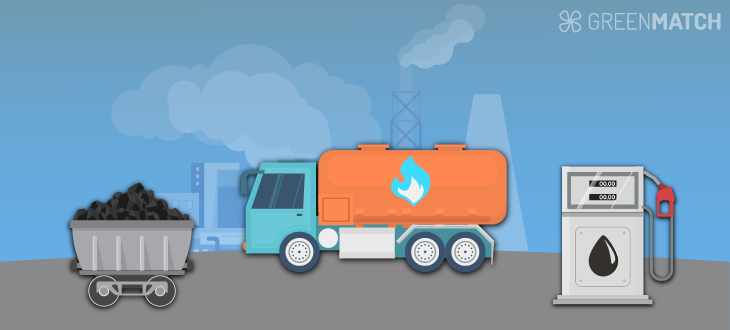
A report from Greenpeace Southeast Asia and the Center for Research on Energy and Clean Air (CREA) estimated global economic losses from fossil fuel air pollution at £2.2 trillion each year, or approximately 3.3 per cent of global GDP. In the United States alone, air pollution from burning fossil fuels is linked to an estimated 230,000 deaths and £450 billion in economic losses annually.
Despite these alarming figures, fossil fuels still supply around 80% of the world's energy. Fossil fuel companies continue to produce and sell fossil fuel products, even as scientists advocate for a mass switch to renewable energy.
This article explores why fossil fuels are detrimental to our planet, providing an in-depth analysis of their impact on our environment and health and the economic implications of their continued use.
Understanding Fossil Fuels
Earth's history, fossil fuels—coal, oil, and natural gas—have played a pivotal role in powering human civilisation. These ancient energy sources—coal, oil, and natural gas—have been the bedrock of our energy consumption, shaping economies and powering nations.
But what exactly are fossil fuels, and how did they become the powerhouse of our energy needs?
The Formation of Fossil Fuels
Fossil fuels are hydrocarbon deposits, such as coal, petroleum, and natural gas, derived from the organic remains of prehistoric plants and animals. Their formation is a testament to geologic time's slow but relentless forces.
Coal, the first to be widely used, is a remnant of ancient swamp forests, where plant material accumulated in low-oxygen conditions, preventing decay and allowing for peat formation, which eventually became coal through further geological processes.
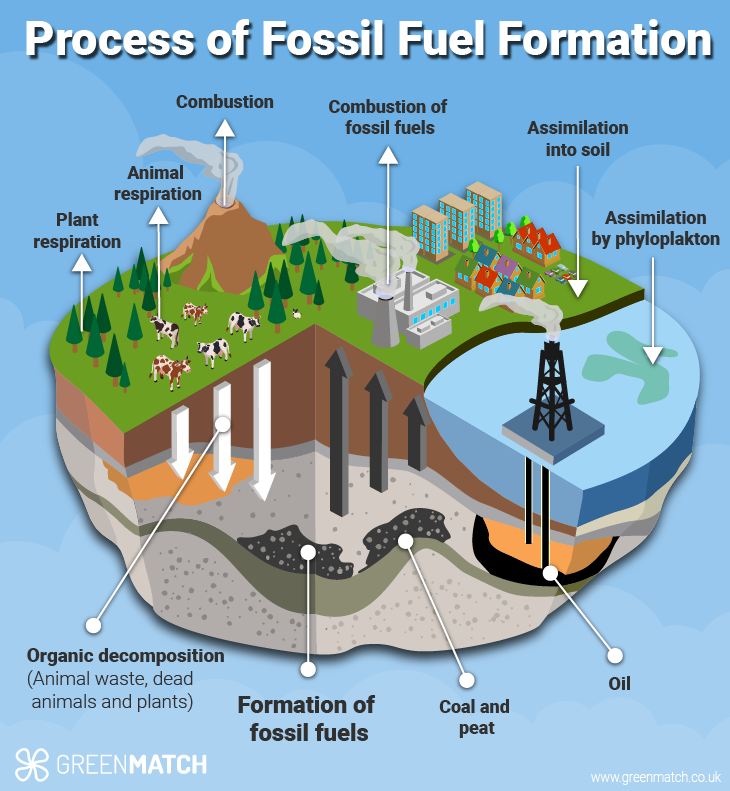
Petroleum and natural gas, on the other hand, originated from marine organisms such as algae and plankton. Their remains settled on ocean floors, mixed with sediments, and over aeons, converted into the viscous and gaseous hydrocarbons we exploit today.
Types of Fossil Fuels
The three main types of fossil fuels are:
- Coal: The oldest and once the most abundant, it is a solid, carbon-rich material often used in power generation. Coal is a combustible black or brownish-black sedimentary rock with high carbon and hydrocarbons. It is classified into four main types, or ranks: anthracite, bituminous, subbituminous, and lignite, depending on the types and amounts of carbon it contains and the quantity of heat energy it can produce.
- Oil (Petroleum): A liquid composed of complex hydrocarbons, refined into fuels like gasoline and diesel and used to produce plastics and pharmaceuticals.
- Natural Gas: Primarily methane, it is a cleaner-burning fuel used for heating, cooking, and electricity generation. It also includes ethane, propane, butane, and pentane.
Economic Considerations
The economic implications of fossil fuels are profound. They have been the engine of economic growth since the Industrial Revolution, but their reserves are finite and dwindling. The cost of their environmental and health impacts is also significant.
For instance, air pollution from fossil fuels is estimated to cost the global economy £2.2 trillion annually, or about 3.3 per cent of global GDP.
To better understand the scale and impact of fossil fuels, let's consider a data table that outlines the key characteristics and economic aspects of each type:
| Fossil Fuel Type | Main Uses | Estimated Global Reserves |
|---|---|---|
| Coal | Electricity, Steel Production | Declining, but varies by region |
| Oil (Petroleum) | Fuel, Plastics, Pharmaceuticals | Predicted peak by 2050 |
| Natural Gas | Heating, Cooking, Electricity | Accounts for a fifth of the world's carbon emissions |
The Impact of Fossil Fuels
While fossil fuels have been instrumental in driving industrial development and economic growth, their extraction and use have significant environmental and health implications.
Burning fossil fuels releases large quantities of carbon dioxide, a greenhouse gas contributing to global warming. Moreover, air pollution from fossil fuels is linked to a range of health issues, including respiratory disorders and premature death.
Environmental Impact of Fossil Fuels
The environmental impact of fossil fuels is profound and far-reaching. As we continue to rely on these non-renewable resources for our energy needs, it is crucial to understand their environmental consequences and explore sustainable and renewable alternatives. The future of our planet depends on our actions today.
| Environmental Impact | Description |
|---|---|
| Greenhouse Gas Emissions | Fossil fuels contributed to 78% of the increase in total greenhouse gas emissions from 1970 to 2010. |
| Air Pollution | Air pollution from fossil fuels was responsible for about 1 in 5 deaths worldwide in 2018. |
| Water Pollution | Oil spills and coal mining contaminate water bodies, harming aquatic life and human health. |
| Impact on Land and Biodiversity | Fossil fuel extraction and climate change can lead to habitat loss, biodiversity decline, and species extinction. |
Greenhouse Gas Emissions and Climate Change
Fossil fuels are the most significant contributor to global climate change, accounting for over 75% of global greenhouse gas emissions and nearly 90% of all carbon dioxide emissions.
When fossil fuels are burned, they release large amounts of carbon dioxide, a greenhouse gas, into the air. This traps heat in our atmosphere, causing global warming. The Intergovernmental Panel on Climate Change (IPCC) warns that fossil fuel emissions must be halved within 11 years if global warming is to be limited.
Air Pollution and Human Health
Burning fossil fuels releases sulfur dioxide, nitrogen oxides, and particulate matter. These pollutants can cause a range of health problems, including respiratory diseases, heart disease, and stroke. According to the World Health Organization, air pollution causes an estimated 7 million premature deaths yearly.
Water Pollution from Fossil Fuel Extraction
The extraction and usage of fossil fuels also lead to significant water pollution. Coal mining operations can wash toxic runoff into waterways, while oil spills and leaks during extraction or transport can devastate freshwater and ocean ecosystems. Fracking and other drilling operations generate wastewater laden with heavy metals and radioactive materials, posing further risks to water quality.
Impact on Land and Biodiversity
Fossil fuel exploitation directly and indirectly impacts biodiversity. Habitat conversion, degradation, pollution, and disturbance at extraction sites lead to biodiversity loss and fragmentation of critical wildlife habitats. This not only threatens individual species but also the stability of entire ecosystems.
For example, mountaintop removal mining, a method used to extract coal, involves removing the tops of mountains, which can destroy large forest areas and bury streams.
| Greenhouse Gas Emissions (GtCO2e/year) | Air Pollution Deaths (Millions/year) | Major Oil Spills (Number/year) | Land Disturbed (km2/year) |
|---|---|---|---|
| 36.2 | 7 | 1.3 | 20,000 |
To illustrate the environmental impact of fossil fuels, see the data table below:
| Environmental Impact | Data Point |
|---|---|
| Global GHG Emissions from Fossil Fuels | 75% from Fossil Fuels |
| Carbon Dioxide Emissions from Fossil Fuels | 90% from Fossil Fuels |
| Deaths Linked to Fossil Fuel Air Pollution (Annually) | 1 in 5 Worldwide |
| Water Consumption by Oil and Gas Industries (California) | 280 Billion Gallons |
| Increase in CO2 Emissions from Coal (2021) | 15% |
| Sea Level Rise | Increased Risk of Storm Surges |
| Extreme Weather Events | 93% of Heat Events Worsened |
| Biodiversity Loss | Direct and Indirect Impacts |
Fossil Fuels and Climate Change
The evidence is clear: fossil fuels are a driving force behind climate change, with severe implications for our environment, health, and economy. Transitioning to renewable energy sources and reducing greenhouse gas emissions are critical to mitigating these impacts.
| Greenhouse Gas Emissions (GtCO2e/year) | Sea Level Rise (mm/year) | Extreme Weather Events (Number/year) | Species at Risk of Extinction (%) |
|---|---|---|---|
| 36.2 | 3.3 | 200 | 14 |
This is because burning fossil fuels has been the cornerstone of the modern industrial era, providing the energy that powers our cities, fuels our vehicles, and drives economic growth. Fossil fuels continued to represent 80% of the total energy supply globally, with oil comprising nearly 30%, followed by coal (27%) and natural gas (24%). However, this progress comes at a steep environmental cost, particularly in the form of climate change.
This is to say that fossil fuels, including coal, oil, and gas, are the predominant sources of greenhouse gas emissions, contributing over 75% of global emissions and nearly 90% of all carbon dioxide emissions.
Studies have shown that 93% of extreme heat events assessed by scientists were made more likely or severe due to climate change. The United Kingdom, for example, is witnessing unexpected patterns of extreme weather, including heatwaves, storms, and flooding, which are becoming more severe and frequent
| Year | Global Fossil Fuel Consumption (in million tonnes of oil equivalent) | Global CO2 Emissions (in billion tonnes) |
|---|---|---|
| 2020 | 11,700 | 33.2 |
| 2021 | 11,900 | 34.1 |
| 2022 | 12,100 | 35.0 |
| 2023 | 12,300 | 35.9 |
| 2024 | 12,500 | 36.8 |
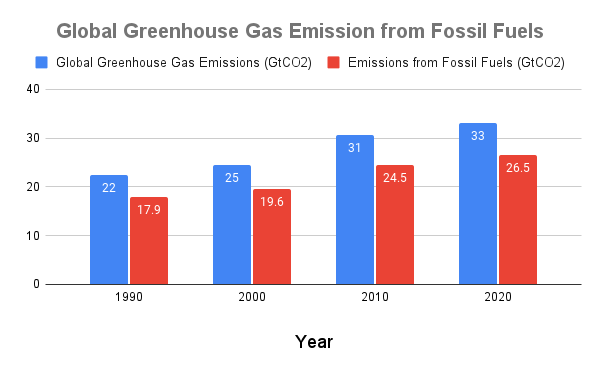
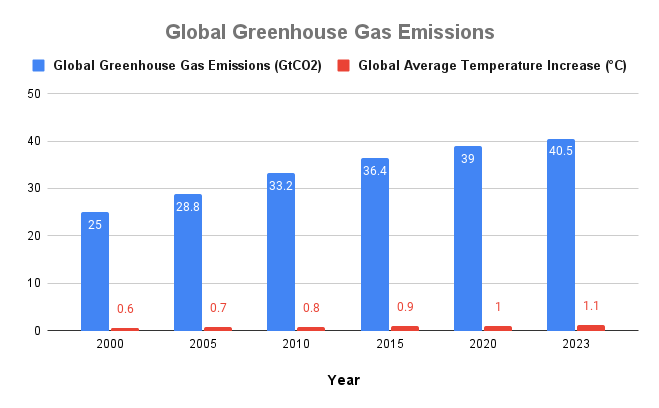
Fossil Fuel Consumption by Top Countries
The reliance on fossil fuels remains high, particularly in countries with significant production capabilities or high industrial and commercial energy needs.
Top Consumers of Fossil Fuels
According to recent data, China, the United States, and India are the leading consumers of fossil fuels in absolute terms. In 2022, China's primary energy consumption was 159.39 exajoules, followed by the United States at 95.91 exajoules and India at 36.44 exajoules.
These figures reflect the total energy needs of these countries, including the energy required to produce fuel and electricity. Statista and OurWorld in Data
Top Five Countries by Total Fossil Fuel Consumption
- China: With a consumption of 159.39 exajoules, China leads the world in total fossil fuel consumption. Despite its efforts to increase renewable energy use, China's rapid industrial growth and large population make it the largest consumer of fossil fuels.
- United States: The United States follows China with a consumption of 95.91 exajoules1. The US has a high per capita consumption rate, with each person consuming approximately 63,836 kWh in 2022.
- India: with 36.44 exajoules, India is the third-largest fossil fuel consumer. Its per capita consumption is lower than that of the US due to its large population.
- Russia: Russia consumed 28.89 exajoules of fossil fuels in 2022. Its vast natural gas and oil reserves contribute significantly to its high consumption.
- Japan: Japan, with its highly industrialised economy, is the fifth-largest consumer of fossil fuels.
The following table outlines the fossil fuel consumption of the top countries, providing a clear picture of the global energy landscape.
| Country | Coal (Million Tonnes) | Oil (Million Tonnes) | Natural Gas (Billion Cubic Metres) | Total Fossil Fuel Consumption (Mtoe) |
|---|---|---|---|---|
| China | 3,523 | 640 | 306 | 4,569 |
| United States | 661 | 919 | 832 | 2,412 |
| India | 966 | 221 | 58 | 1,245 |
| Russia | 228 | 151 | 402 | 781 |
| Japan | 203 | 215 | 132 | 550 |
Per Capita Consumption
When examining fossil fuel consumption per capita, the landscape changes significantly. The United States, for instance, has a much higher per capita consumption compared to China and India. This indicates the average American's higher standard of living and the more energy-intensive lifestyle.
Countries like Qatar, Trinidad and Tobago, and Kuwait have some of the world's highest per capita fossil fuel consumption rates, often exceeding 10 tons per person annually. For instance, Qatar's residents used up nearly 165,000 kilowatt-hours per person in 2020, the highest in the world.
This starkly contrasts countries with large populations like China and India, where per capita consumption is much lower due to the dilution effect of their large populations. However, these countries are not among the top consumers in absolute terms due to their smaller populations and economies.
Top Five Countries by Per Capita Fossil Fuel Consumption
The list of top countries changes when considering per capita fossil fuel consumption. The United States still leads, but other countries like Australia, Germany, Europe (as a whole), and China also feature prominently. Source
- United States: With a per capita consumption of 63,836 kWh, the United States leads the world in per capita fossil fuel consumption.
- Australia: Australia follows with a per capita consumption of 54,286 kWh. Australia's high per capita consumption is due to its reliance on coal for electricity generation and its extensive mining industry.
- Germany: Germany's per capita consumption stands at 31,225 kWh. Despite its efforts to transition to renewable energy, Germany still relies heavily on fossil fuels, particularly coal.
- Europe: Europe has a per capita consumption of 28,721 kWh. This figure varies widely among European countries, with some, like Germany, having higher rates and others having lower rates.
- China: Despite being the largest total consumer of fossil fuels, China's per capita consumption is lower at 25,344 kWh due to its large population.

Fossil Fuel Dependence
The reliance on fossil fuels varies significantly by country. Some nations, such as Qatar and Algeria, have fossil fuel energy consumption rates of nearly 100% of their total energy use. This heavy dependence on fossil fuels is often due to a lack of domestic renewable energy sources or the economic benefits of exploiting abundant fossil fuel reserves.
| Country | Fossil Fuel Consumption (metric tons per capita) |
|---|---|
| Qatar | 165,000 kWh |
| Equatorial Guinea | >10 tons |
| Kuwait | >10 tons |
| United States | >20 tons (63,836 kWh) |
| China | 3.4 tons (25,344 kWh) |
Environmental Impact
Burning fossil fuels releases large quantities of carbon dioxide, contributing to climate change and air pollution. Countries with high fossil fuel consumption are also the largest emitters of carbon dioxide, with China, the U.S., India, Russia, and Japan being responsible for 60% of the world's total emissions.
Can We Get Rid of Fossil Fuels?
Whether we can eliminate our reliance on fossil fuels is a complex and pressing issue. However, continued fossil fuel use's detrimental environmental and health impacts have sparked a growing urgency to transition to cleaner, renewable energy sources.
The Significance of Reducing Reliance on Fossil Fuels
Reducing reliance on fossil fuels is crucial for several reasons.
Firstly, burning fossil fuels releases carbon dioxide (CO2), a greenhouse gas contributing to global warming. Secondly, fossil fuels are a finite resource and will eventually run out. Lastly, the extraction and use of fossil fuels can lead to environmental degradation and health problems.
The Challenges of Transitioning Away from Fossil Fuels
While removing fossil fuels is technically possible, the transition to a cleaner, renewable energy future is challenging.
For instance, according to the International Renewable Energy Agency, a global effort to fund 100% renewable energy by 2050 could cost £131 trillion. The existing infrastructure in most countries is primarily fossil-fuel-based, and transitioning to a renewable energy base would require substantial changes to this infrastructure.
The pace of this transition will be a key determinant of our ability to mitigate the worst impacts of climate change and build a sustainable future.
| Fossil Fuel | Major Pollutants Released | Health Impacts | Environmental Impacts |
|---|---|---|---|
| Coal | Mercury, Lead, Sulfur Dioxide | Respiratory diseases, Neurological damage | Air pollution, Acid rain |
| Oil | Benzene, Toluene, Heavy Metals | Respiratory diseases, Cancer | Oil spills, Water pollution |
| Natural Gas | Methane, Nitrogen Oxides | Respiratory diseases | Greenhouse gas emissions |
Is Fossil Fuels Toxic?
Fossil fuels contain harmful substances that can be released into the environment during extraction, processing, and combustion. These include heavy metals like mercury, lead, arsenic, sulfur, and nitrogen compounds.
According to a study by the International Monetary Fund, the global cost of fossil fuel air pollution reached £4.7 trillion in 2020, equivalent to 6.3% of global GDP. This includes the costs of premature deaths, healthcare expenses, and lost productivity due to illness.
This means that when these substances are released into the atmosphere, they can contribute to air pollution, a significant cause of respiratory diseases and other health problems. According to the World Health Organization, air pollution causes an estimated 7 million premature deaths yearly.
Biodegradability of Fossil Fuels
Fossil fuels are not biodegradable. However, certain microorganisms, known as bioremediation, can degrade pollutants from fossil fuels. This process involves using microorganisms and their biodegradative capacity to remove pollutants.
In addition, fossil fuels, such as petroleum, are complex mixtures of hydrocarbons. The biodegradation of these hydrocarbons is a complex process that depends on the nature and amount of the oil and the environmental conditions.
However, it's important to note that petroleum (crude oil) is toxic and not readily biodegradable. Any spill harms the environment. The biodegradability of biodiesel was higher than 98% after 28 days, while for diesel fuel and gasoline, it was 50% and 56%, respectively.
Factors Affecting Biodegradation
The biodegradation process is affected by many factors, including polymer properties, exposure conditions, and enzyme properties.
Environmental conditions such as humidity, pH, temperature, and enzyme characteristics of the degrading microorganisms can influence the biodegradation rate.
Alternatives to Fossil Fuels
Despite the clear evidence of the harm caused by fossil fuels, the world remains heavily reliant on them. However, the tide is turning. There is a growing recognition of the need to transition to cleaner, renewable energy sources, such as solar, wind, geothermal, and nuclear power. These alternatives are not only better for the environment and our health, but they also offer significant economic opportunities.
Exploring Alternatives to Fossil Fuels
Given these impacts, there is a growing interest in alternative energy sources.
- Renewable Energy: This includes wind, solar, tidal, and hydroelectric energy. Unlike fossil fuels, these sources are theoretically infinite and will eventually run out.
- Nuclear Power: While controversial due to the potential for accidents and the challenge of waste disposal, nuclear power is a low-carbon energy source that can generate large amounts of power.
- Hydrogen: Hydrogen can be used as a clean-burning fuel, but challenges remain regarding production, storage, and transportation.
- Biomass: Biomass energy involves burning organic materials to produce heat. While renewable, it can also contribute to deforestation and air pollution.
- Geothermal Energy: This involves harnessing the heat from the earth's core but is limited by geographical constraints.
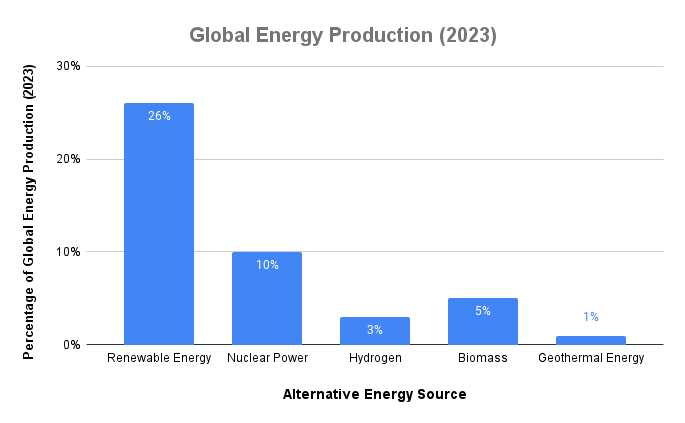
| Energy Source | Global Capacity (GW) | Yearly Growth Rate (%) | CO2 Emissions Reduction (Million Tonnes) |
|---|---|---|---|
| Solar Power | 707 | 22 | 1,100 |
| Wind Energy | 743 | 12 | 1,500 |
| Hydrogen | 0.7 | 10 | 900 |
| Geothermal | 14 | 5 | 60 |
| Nuclear | 392 | 1 | 2,500 |
However, each of these alternatives has its own set of challenges. For instance, renewable energy sources like wind and solar depend on weather conditions, and while clean, nuclear power poses risks related to safety and waste disposal.
Rise of Renewable Energy
Despite these challenges, the transition to renewable energy is underway. The share of primary energy consumption from renewable sources is growing quickly in many countries worldwide. According to the International Renewable Energy Agency (IRENA), renewable power generation capacity has increased annually.
Here is a table showing the growth of renewable energy in the top five countries in terms of primary energy consumption:
The Future of Fossil Fuels
While the transition to renewable energy is promising, fossil fuels are still expected to play a significant role in the global energy mix for the foreseeable future. According to a report by scientists from more than 90 institutions, countries are expected to emit 36.8 billion metric tons of CO2 from fossil fuels in 2023, a 1.1% increase from the previous year.
According to the International Energy Agency, the share of fossil fuels in the global energy supply is expected to decline from around 80% to 73% by 2030, with global energy-related CO2 emissions peaking by 2025.
This suggests that the transition to clean energy is happening worldwide and is unstoppable.
The question is not if we can eliminate fossil fuels but how quickly we can do so. The answer to that question will depend on the collective actions which require careful planning, investment, and international cooperation to ensure a sustainable and secure energy future.
While the challenges are significant, the imperative to end our dependence on fossil fuels is clear, and the benefits of doing so are profound.

Inemesit is a seasoned content writer with 9 years of experience in B2B and B2C. Her expertise in sustainability and green technologies guides readers towards eco-friendly choices, significantly contributing to the field of renewable energy and environmental sustainability.
We strive to connect our customers with the right product and supplier. Would you like to be part of GreenMatch?

